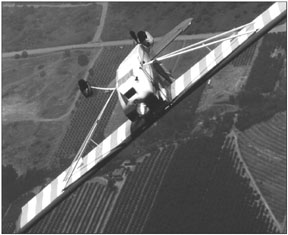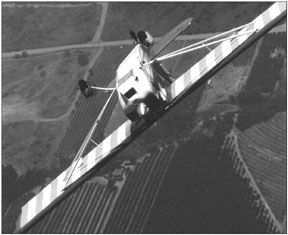
by Rich Stowell
In 1998, the FAA unveiled its Safer Skies Agenda. The agenda represented a renewed commitment between the FAA and industry to minimize aviation accidents. Six broad categories were established to classify the majority of accidents. Under general aviation, loss of control came in second behind pilot decision-making; loss of control ranked second for commercial aviation as well, edged out by controlled flight into terrain. The loss-of-control category includes accidents resulting from stalls, spins, and upsets-where upsets typically refer to uncontrolled or uncommanded changes in an airplanes pitch attitude and/or bank angle not necessarily associated with a stall/spin.
Upset recovery has become increasingly popular in recent years. Airlines and corporate flight departments, for instance, now upset recovery into their training programs. Pilots flying for a number of government agencies are required to take recurrent upset training as well. In 2001, the FAA released a 30-minute video entitled, Avoiding Airplane Upsets. And NASA published a study in 2002 evaluating upset training for newly hired airline pilots (Airplane Upset Training Evaluation Report, NASA/CR-2002-211405, May 2002).
How Do Upsets Happen?
The upset can be created either by the pilot, by mechanical problems with the aircraft, or by the environment. Pilot-induced upsets, for example, often occur as a result of botched maneuvers: steep turns gone wrong, enthusiastic rather than lazy eights and blown aerobatic figures. Similarly, spatial disorientation at night or while in instrument conditions can lead to the infamous graveyard spiral.
Mechanical problems involving the primary or secondary controls-jammed ailerons, runaway trim, split flaps, to name only a few-can also precipitate an aircraft-induced upset.
An example of an environment-induced upset is wake turbulence.Encountering the wake generated by a heavy, slow aircraft from a perpendicular flight path could cause an uncommanded pitch excursion rapid enough to impose unacceptable loads on the airframe. Encountering wake turbulence along a parallel flight path might result in an uncommanded roll excursion toward an inverted attitude.
Weather can be responsible for upsets, too. Obvious examples are the turbulence associated with thunderstorms and mountain wave activity. Airframe ice-especially supercooled large droplets (SLDs)-is another example.
Elements Of Recovery
More and more airline pilots are coming from general aviation; consequently, NASAs study tested non-military pilots in their probationary year with airlines operating in the U.S. Although the study focused on Transport category operations, the core elements of upset recovery are applicable to both the general aviation and commercial flight environments. Those actions can easily be remembered as Power–Push–Roll.
Looking at the primary upset recovery actions primarily in the context of light aircraft will serve not only the majority of pilots, but will also lay the foundation for aspiring airline pilots as they transition to larger, heavier aircraft.
Energy And Power
Upon recognizing the upset, its important quickly to assess the energy state of the aircraft. Nose high and decaying airspeed? In light aircraft, maintaining or even adding power can reduce the rate at which kinetic energy is dissipating. Even so, if any doubt exists as to what to do with the power, simply close the throttle. Whatever the power setting, gravity will ensure that a light airplanes nose will eventually point downhill.
Nose low and rapidly increasing airspeed? Reducing power will slow the buildup of kinetic energy. In airplanes with fixed-pitch propellers, reducing the power also provides a greater margin against overspeeding the prop/engine.
Push Or Pull?
Pushing on the elevator/stabilator control goes completely against our natural instincts, especially when in a nose-low unusual attitude. The push response, however, must be mastered for several reasons: First, pushing on the elevator control reduces the wings angle of attack, thereby providing a greater margin to the stall (or unstalling the wing if thats part of the problem).
Second, pushing reduces the g-load imposed on the airframe, thereby providing a greater margin for structural design limits. This is no small point. Design limits for a given aircraft vary based on many factors. For example, the design limit for Normal category operations fluctuates as follows: from +3.8-g flaps-up with symmetric g-loading (pulling only, no rolling); to +2.5-g flaps-up with asymmetric g-loading (simultaneously pulling and rolling); to as low as +2.0-g flaps-down with symmetric g-loading.
Third, in the case of a nose-high attitude, pushing pitches the nose toward the horizon. In a nose-low, banked attitude, pushing slows the rate at which the airplane pitches away from the horizon.
The push input should re-establish a normal, +1.0-g feel in the seat of your pants. This is the appropriate push when recovering from a nose-low, banked attitude. At most, the push should cause you to feel light in your seat, approaching zero-g without crossing into negative-g territory. This is appropriate when recovering from a nose-high attitude.
Leveling The Wings
Once the airplanes energy state and pitch attitude are under control, the bank angle becomes the focus. Get the airplane rolling in the shortest direction toward the horizon line. For instance, roll left if nose-high and banked to the left; roll right if nose-low and banked to the left. Apply coordinating rudder if able, but dont worry so much about the rudder that it detracts from applying the aileron input.
Unfortunately, some pilots are taught to rely too heavily on the rudder during upset recoveries. Although overusing the rudder in a light airplane might still get the job done, it is less efficient than focusing on the primary roll control. And in Transport category aircraft, overusing the rudder can have serious structural and aerodynamic ramifications. The focus, therefore, needs to be on rolling with the ailerons.
Its important to note that not all upset recoveries require aggressive control inputs, either. High-altitude upsets, for instance, demand finesse on the controls during recovery, particularly in Transport category aircraft.Hence, its important to emphasize the conditions under which each technique must be applied.
Practice Makes Perfect
The NASA study noted that repetitive practice plays an important role in a pilots ability to recognize the upset and to apply the correct response.Practice is crucial regardless of the type of aircraft you fly, so here are a few exercises to help you develop the requisite recovery reflexes.
After clearing the practice area, stabilize the airplane in a slow cruise configuration below the published maneuvering speed. Look over the nose at a point on the horizon. Smoothly apply left aileron and a small amount of left rudder, rolling into a 30-degree bank, then instantly but smoothly apply right aileron and some right rudder. Bank continuously from side to side, focusing on the aileron as the primary input. Rudder input should smaller-just enough to keep the nose of the airplane on the reference point.
As skills improve, increase the bank angle to 45 degrees or more.Experiment with greater aileron deflection as well. Apply the rudder simultaneously, but only enough for the nose to remain on your reference point-do not stare at the ball! Be aware of any tendency to pull on the stick/yoke during the exercise, which will pull the nose away from the reference point.
A variation involves performing a level turn, but only after first establishing the bank angle. Set up the airplane the same way, but pick two reference points on the horizon: one over the nose and a second off your left wingtip. Roll left to a 45-degree bank or so, without turning. The instant you reach your target bank angle, neutralize the aileron and rudder inputs.Now smoothly apply enough back pressure to pull the nose along the horizon in a coordinated, level turn.
Upon reaching your second reference point, release back elevator pressure to stop the nose on the point. Apply coordinated right aileron and right rudder, rolling into a 45-degree bank to the right. Neutralize aileron and rudder inputs. Pull the nose back to your starting point in another coordinated, level turn. Release the back pressure first upon reaching your original heading, then roll to wings level.
Repeat, each time adding more aileron when changing bank angle. Keep the aileron and elevator actions separate from each other, too-either roll or pitch, but not both. Return aileron and rudder to neutral before applying the aft elevator and return the aft elevator to neutral before applying aileron and rudder.
The third exercise involves pitching the airplane to a wings-level, nose-up attitude, then applying forward elevator while banking toward the horizon.From the same cruise configuration, pitch the nose 20-30 degrees above the horizon. Smoothly push forward on the stick/yoke. Begin rolling toward the horizon with coordinated aileron and rudder inputs. As you gain experience, work your way up to a 60-degree bank. Roll back to wings-level upon reaching the horizon. As a variation, allow more and more airspeed to dissipate before initiating the recovery.
Better yet, consider signing up for a couple of hours of upset recovery training in an aerobatic airplane to explore the envelope more fully.
Also With This Article
“Principles Of Upset Recovery”
“How Upsets Happen”
“Upset Recovery Training Exercises”
-Rich Stowell is a NAFI Master Instructor of Aerobatics who specializes in spin, emergency maneuver and aerobatic training. He has performed more than 25,000 spins with students in his 6100 hours of flight instruction.




